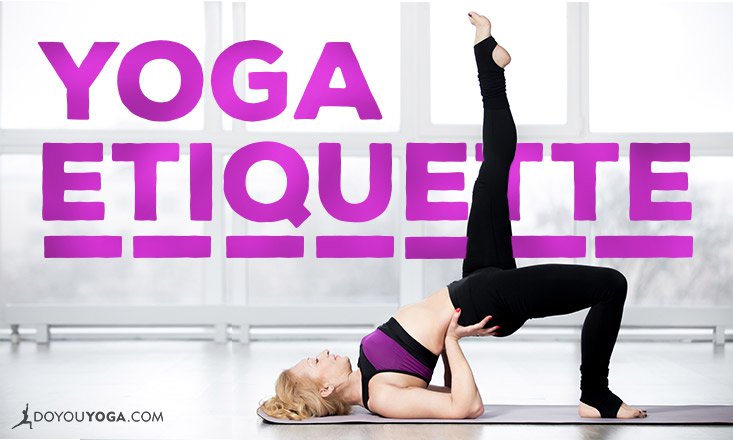Confused by what you should and shouldn’t do when it comes to yoga class? If the rules are unclear, here is a simple guide to help you understand the right (and wrong!) way to prepare and conduct yourself in yoga class.
Obviously, this yoga etiquette 101 list is in no way exhaustive and different studios and yoga teachers might have different "rules" of their own. These are just a couple of the most common 'rules' I'd recommend you keep in mind for your next yoga class.
1. Take a shower BEFORE class.
It seems counterproductive, since you’re going to sweat it out anyways, but yoga class is a very intimate environment. Your feet are bare, your bum is in the air, and chances are you aren’t wearing any underwear (wedgie!).
A quick rinse-off with shea butter and essential oil soap cleanses the body of dirt, oils, and impurities. An asana practice should be ritualistic, and showing up with a clean body is part of this ritual and shows respect for your practice.
Some yoga disciples encourage engaging in kriyas (cleansing techniques) to keep the body pure and clean. Personally, I practice neti (cleansing the nasal passages), Hrid Dhauti and Danta Dhauti (cleaning the tongue and teeth), and nauli (engaging the abdominal muscles to tone the liver and aid in digestion) every morning before asana class.
2. Skip the perfumes and scented lotion.
I get that you want to smell good, but chemical scents are NOT attractive. They can trigger allergies in other students, are distracting during practice, not to mention they are toxic to the environment.
Try products made with natural essential oils like Badger Balm skin ointments or coconut butter infused with lavender. Welda makes a great line of natural spray deodorants that are free from aluminum and synthetic fragrances.
If you are practicing a yogic diet along with your asana practice, eventually you won’t need synthetic antiperspirants because your sweat won't stink like decomposing meat, dairy, alcohol and caffeine. These substances makes the blood acidic, which creates a chemical reaction in the body to neutralize the acid as it establishes homeostasis.
The result is some stinky B.O. and poo-poo. So skip the Bath and Body Works body spray and go for something much more eco-friendly.
3. Empty your bowel and bladder.
This might seem like common sense, but when you are leaving work to make it to class or just getting up in the morning, take the time to use the bathroom properly. This will avoid distractions during class, including the need to leave in the middle of practice.
When the pelvis and abdomen are free from excess waste, the body fluids can move more freely during the asanas to help detoxify and nourish the body properly.
4. Avoid eating at least 2 hours before class.
The body should be focusing on the healing power and benefits of the asanas rather than digesting food. Twisting postures stimulate the digestive fire (agni) and work best if the digestive system is at rest.
If you are worried about low blood sugar or electrolyte abnormalities, be sure to drink lots of fluids two hours leading up to your class.
5. Leave your shoes at the door.
This tradition goes back thousands of years, and continues today. Don’t enter the studio to set up your mat with your shoes on. And don’t practice with your socks or shoes on — it’s just weird.
Working out barefoot can feel funny if you’re not used to it, but removing your shoes is not only respectful, it strengthens the arches of the feet, improves balance and sensation, and helps you tune into your emotional being.
If hygiene is an issue, wear your socks into the room and remove them once you are on your mat.
6. Sign in and pay BEFORE class.
Depending on your local studio, they may or may not have a receptionist to check you in. Most of the time, the teacher is also the person who accepts payment and checks students into class.
Skipping the front desk and heading straight for the studio is rude. If you are running a little late, ask if it’s okay if you check in and pay after class. Chances are the teacher won’t mind, or they will be okay starting a few minutes late to take payment.
7. Stay for Savasana.
The final resting place at the end of class is the most important posture. This is where all the benefits of the yoga asanas are received, as the body is calmed and ready to enjoy them.
This is when the blood pressure normalizes, heart rate and breathing is steadied, and the cells begin to regenerate as the body heals itself. When I first started taking yoga classes, this was the most difficult pose for me. Every part of me wanted to get up and leave class.
As my practice advanced, the stillness became easier and is now welcomed with ease and joy. If, for some reason, you need to leave class early, let your teacher know. He or she can let you know when your time is up so you can take a brief Savasana before you need to leave.
8. Practice ahimsa.
This Ashtanga yoga discipline refers to nonviolence. Nonviolence not only refers to avoiding harm to others in a physical sense, but also to avoid harmful thoughts and words towards all beings.
On a more personal level, we should be careful and gentle to our thoughts and actions to ourselves. This includes our asana practice — we shouldn’t push ourselves too hard or think negative thoughts about ourselves or others. Recognize that each day is different and brings new challenges.
Are there are other 'rules' and etiquette that you follow in yoga class? Share your thoughts, comments, and questions below!
Note: This article has been updated 07/31/2016


